Designing Buildings Around Cars Will Only Make Our Car Problem Worse
Few people would disagree that the city has a serious parking problem—but the debate that erupted surrounding a proposed Allston apartment building that wouldn’t allow room for off-street parking shows a big difference in opinion over whether we can solve it.
Architect Sebastian Mariscal’s proposal for a 44-unit apartment building—which originally included no parking spaces for cars—stood at the center of the controversy. Under current zoning regulations, new developments in the Allston-Brighton neighborhood with 10 or more units are required to include two parking spaces for every dwelling unit—otherwise, they must receive special permission from regulators to include fewer spaces.
The debate has divided people into one of two camps. On one side are those who see the car-free building as part of the solution to our parking problem, and on the other are those convinced that such an undertaking could only make the existing problem worse.
Constructing a building that replaces parked cars with bike racks, storage, and shared car services encourages people to take mass transit, bike, or walk—a fact which the project’s detractors readily acknowledge. And with the site of the proposed project just a 10-miute walk from the Green Line and a 5-minute walk from a planned commuter rail stop, its future tenants would readily be able to get around town without cars. But alas, there’s no way to guarantee they wouldn’t just park cars on the street, critics argue. Even if tenants were to sign away the right to own a car as a condition of the lease—like Mariscal said he would require—there would ultimately be no way to stop them from lying and parking on the street anyway.
But when you consider the support that the project has generated so far, along with the fact that that 45 percent of renters currently living in Allston don’t own cars, is it really so hard to believe that Mariscal would be able to find the roughly 150 tenants without cars (and without any secret cars stashed on some side street of Boston) that he’d need to lease the apartment building to capacity?
If we resign ourselves to believe that the number of cars in Boston will inevitably continue to tick upwards with time, then the only way to approach the problems they create is with measures designed to control them. We come up with solutions like minimum-parking requirements, while ignoring the fact that these cars are only going to further back up traffic on the city’s overcrowded streets—even if they won’t be parked on them overnight.
Boston wasn’t built for cars, and we need to acknowledge that reality if we ever hope to develop real solutions to the problems that they create. If we continue to design our buildings around them and create new places for people to keep them, then we’re only going to end up with more and more cars in Boston and with more and more of the problems that they create. If we have any hope of reducing our city’s parking woes, then we need to shift they way we think. As Boston continues to develop, we need to stop coming up with rules and regulations to accommodate cars, and instead develop new ways to facilitate people to live without them.
Officially, Mariscal’s proposal for a car-free apartment building is dead—he’s agreed to modify his original plan to include 35 parking spaces after meeting with Allston residents last week. But unofficially, the idea is still very much alive. Mariscal says that he will continue to seek out tenants without cars in order to prove that his idea is possible. Let’s hope he makes his point in the long run.
Image courtesy of Sebastian Mariscal Studio



